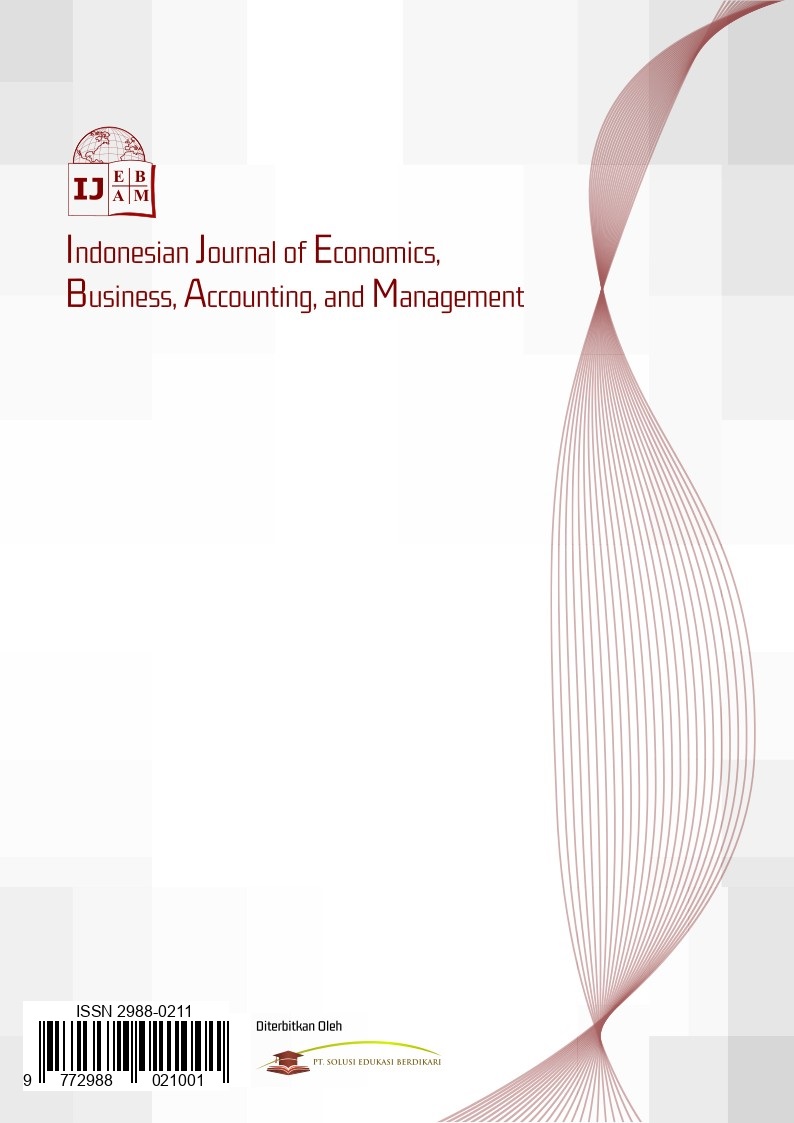Abstract
Small and Medium Enterprises (SMEs) play a role important in economy national Because capable adapt with change and create field work . However , SMEs often face various obstacle in innovate . Research This aim analyze influence obstacle innovation to implementation innovation open as well as the implications to performance SME innovation in Indonesia. Obstacles innovation shared become four group , namely market and institutional barriers , finance , behavior employees and organizations , as well as knowledge and work same . Research results show that market and institutional barriers as well as obstacle behavior employees and organizations influential positive to innovation open , whereas obstacle finance as well as obstacle knowledge and work The same No influential significant . In addition , innovation open influential positive to performance SME innovation . Findings This confirm that innovation open become an important strategy for SMEs to increase Power competition in environment dynamic business .
References
Barriers to Innovation in Indian Small and Medium-Sized Enterprises (Issue 588). (2016). https://www.adb.org/publications/barriers-innovation-indian-small-and-medium-sized-enterprises
Bianchi, M., Campodall’Orto, S., Frattini, F., & Vercesi, P. (2010). Enabling open innovation in small- and medium-sized enterprises: how to find alternative applications for your technologies. R&D Management, 40(4), 414–431. https://doi.org/10.1111/J.1467-9310.2010.00613.X
Buwana, MAL, & Nursyamsiah, S. (2018). Analysis of Open Innovation Implementation: The Role of External Collaboration on Product Innovation and Company Performance (Empirical Study on Batik Small and Medium Enterprises (SMEs) in Yogyakarta). Indonesian Journal of Management and Business , 6 (1), 45–64. https://doi.org/10.31843/JMBI.V6I1.182
Cheng, C. C. J., Yang, C. L., & Sheu, C. (2014). The link between eco-innovation and business performance: a Taiwanese industrial context. Journal of Cleaner Production , 64 , 81–90. https://doi.org/10.1016/J.JCLEPRO.2013.09.050
Chesbrough, H. (2003). Open Innovation: The New Imperative for Creating and Profiting from Technology .
Claver, E., Llopis, J., Garcia, D., & Molina, H. (1998). Organizational culture for innovation and new technological behavior. The Journal of High Technology Management Research, 9(1), 55–68. https://doi.org/10.1016/1047-8310(88)90005-3
Crema, M., Verbano, C., & Venturini, K. (2014). Linking strategy with open innovation and performance in SMEs. Measuring Business Excellence, 18(2), 14–27. https://doi.org/10.1108/MBE-07-2013-0042
Ebersberger, B., & Herstad, S. J. (2013). The relationship between international innovation collaboration, intramural R&D and SMEs’ innovation performance: a quantile regression approach. Applied Economics Letters, 20(7), 626–630. https://doi.org/10.1080/13504851.2012.724158
Fagerberg, J., & Mowery, D. C. (2006). The Oxford Handbook of Innovation. The Oxford Handbook of Innovation, 1–680. https://doi.org/10.1093/OXFORDHB/9780199286805.001.0001
Hadjimanolis, A. (1999). Barriers to innovation for SMEs in a small less developed country (Cyprus). Technovation, 19(9), 561–570. https://doi.org/10.1016/S0166-4972(99)00034-6
Hartono, A., Hartono, A., & Kusumawardhani, R. (2018). SEARCHING WIDELY OR DEEPLY? THE IMPACT OF OPEN INNOVATION ON INNOVATION AND INNOVATION PERFORMANCE AMONG INDONESIAN MANUFACTURING FIRMS. Journal of Indonesian Economy and Business (JIEB), 33(2), 123–142. https://doi.org/10.22146/jieb.29218
Hassan, M. U., Iqbal, Z., Malik, M., & Ahmad, M. I. (2018). Exploring the role of technological developments and open innovation in the survival of SMEs: an empirical study of Pakistan. International Journal of Business Forecasting and Marketing Intelligence, 4(1), 64. https://doi.org/10.1504/IJBFMI.2018.088629
Hermawan, CF (1551109). (2019). The Relationship Between Open Innovation, Use of Management Control Systems and Company Performance (a study of Pharmaceutical Companies in Java) .
Hult, G. T. M., Hurley, R. F., & Knight, G. A. (2004). Innovativeness: Its antecedents and impact on business performance. Industrial Marketing Management , 33 (5), 429–438. https://doi.org/10.1016/J.INDMARMAN.2003.08.015
Katila, R., & Ahuja, G. (2002). Something old, something new: A longitudinal study of search behavior and new product introduction. Academy of Management Journal , 45 (6), 1183–1194. https://doi.org/10.2307/3069433
Kozinets, R. V., De Valck, K., Wojnicki, A. C., & Wilner, S. J. S. (2010). Networked narratives: Understanding word-of-mouth marketing in online communities. Journal of Marketing, 74(2), 71–89. https://doi.org/10.1509/jmkg.74.2.71
Laloux, F. (2015). The Future of Management Is Teal. Strategy+Business, 80, 1–22. https://books.google.com/books/about/The_Future_of_Management.html?id=WxUkuJj0CK4C
Laursen, K., & Salter, A. (2006). Open for innovation: The role of openness in explaining innovation performance among U.K. manufacturing firms. Strategic Management Journal, 27(2), 131–150. https://doi.org/10.1002/SMJ.507
Madrid-Guijarro, A., Garcia, D., & Van Auken, H. (2009). Barriers to Innovation among Spanish Manufacturing SMEs. Journal of Small Business Management, 47(4), 465–488. https://doi.org/10.1111/J.1540-627X.2009.00279.X
Parida, V., Westerberg, M., & Frishammar, J. (2012). Inbound Open Innovation Activities in High-Tech SMEs: The Impact on Innovation Performance. Journal of Small Business Management, 50(2), 283–309. https://doi.org/10.1111/J.1540-627X.2012.00354.X
Popa, S., Soto-Acosta, P., & Martinez-Conesa, I. (2017). Antecedents, moderators, and outcomes of innovation climate and open innovation: An empirical study in SMEs. Technological Forecasting and Social Change, 118, 134–142. https://doi.org/10.1016/J.TECHFORE.2017.02.014
Zwick, T. (2002). Employee resistance against innovations. International Journal of Manpower, 23(6). https://doi.org/10.1108/01437720210446397

This work is licensed under a Creative Commons Attribution-ShareAlike 4.0 International License.

